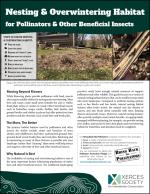As a science-based organization, the Xerces Society produces dozens of publications annually, all of which employ the best available research to guide effective conservation efforts. Our publications range from guidelines for land managers, to brochures offering overviews of key concepts related to invertebrate conservation, from books about supporting pollinators in farmland, to region-specific plant lists. We hope that whatever you are seeking—whether it's guidance on making a home or community garden pollinator-friendly, advice on developing a local pesticide reduction strategy, or detailed information on restoring habitat—you will find it here!
Find Publications
Use the search functions to sort by publication type (books, guidelines, fact sheets, etc.), location, and/or subject (agriculture, gardens, pollinators, pesticides, etc.).
Pollinators in Eastern Deciduous Forests
Although we may think of bees as creatures of sunny meadows and gardens, eastern bees evolved in a historically forested landscape. Precolonial deciduous temperate forests were shifting mosaics of multi-aged vegetation and openings created by disturbances such as disease, storms, wind, beavers, and fire, including through Indigenous stewardship. Therefore, many eastern bee species have evolved to use different ages, elements, and parts of a complex forest system. Here, we outline the various habitat features that define the lives of these bees.
Freshwater mussels are rarely recognized for the important role they play in supporting river, stream, and lake ecosystems. Salmon and other native fish are among the myriad species that benefit from the services mussels provide. Sadly, freshwater mussels are sensitive to changes in their environment and as a group they are among the most imperiled animals in the world.
A Guide to Saving America’s Butterfly
This brochure contains information about how to enhance any landscape to help meet the seasonal needs of monarchs.
Fireflies are some of our most beloved insects: celebrated in art, music, and literature, and contributing to numerous advances in medicine and our understanding of evolution, genetics, and ecology. For many people, their incredible bioluminescent light shows bring up fond memories of childhood. By carefully considering the needs of fireflies and how our actions could affect these animals, we can take steps to ensure that their lights continue to shine for future generations.
A Guide to Protecting Our Vital Pollinators
Bumble bees are an essential part of our wildlands, farms, and urban areas, yet many species are suffering alarming population declines. It is critically important to protect these vital pollinators.
There are simple things you can do to protect or create high-quality bumble bee habitat. Typically, these efforts do not involve significant increases in cost or work, but do require increased awareness and attention to the needs of bumble bees.
This brochure offers an overview of information about how to enhance any landscape to meet the seasonal needs of bumble bees.
And what you can do to help
Butterflies, bees, dragonflies, beetles, spiders, mussels, and other invertebrates sustain life as we know it. Yet many are declining due to habitat loss, pesticide use, climate change, and more. This brochure shows how we depend on invertebrates, introduces the major threats facing them, and lists some steps we can all take. No action is too small to help these tiny but vital animals.
For Pollinators & Other Beneficial Insects
The availability of nesting and overwintering habitat is one of the most important factors influencing populations of native bees and other beneficial insects. This guide focuses on a variety of natural nesting habitat features that can be readily incorporated into most landscapes to benefit pollinators and beneficial insects.
Mulch can be any material intentionally placed on the soil surface that aids in weed suppression, erosion control, and moisture retention, and it can be very helpful in establishing small-scale wildflower plantings with plugs for pollinators and beneficial invertebrates. Mulching can be used both before planting to help prepare the site by smothering existing vegetation and after planting to help suppress weed pressure and retain moisture. It also sends the message that this site is cared for, that these small plants will become something significant.
How to increase native bee pollination on your farm in several simple steps (for Pennsylvania and New Jersey Farmers)
In this pamphlet, you can find out…
- The most effective native bees in PA and NJ and how to identify them
- Their habitat and foraging needs
- Strategies for encouraging their presence on your farm
- Sources of funding
Produced by Bryn Mawr College and Rutgers University
Cut, color, and wear this fun mask to shimmer like a dragonfly! This is an educational craft activity for kids.








